Manipulations with magnetic properties of nanostructures due to the electric field
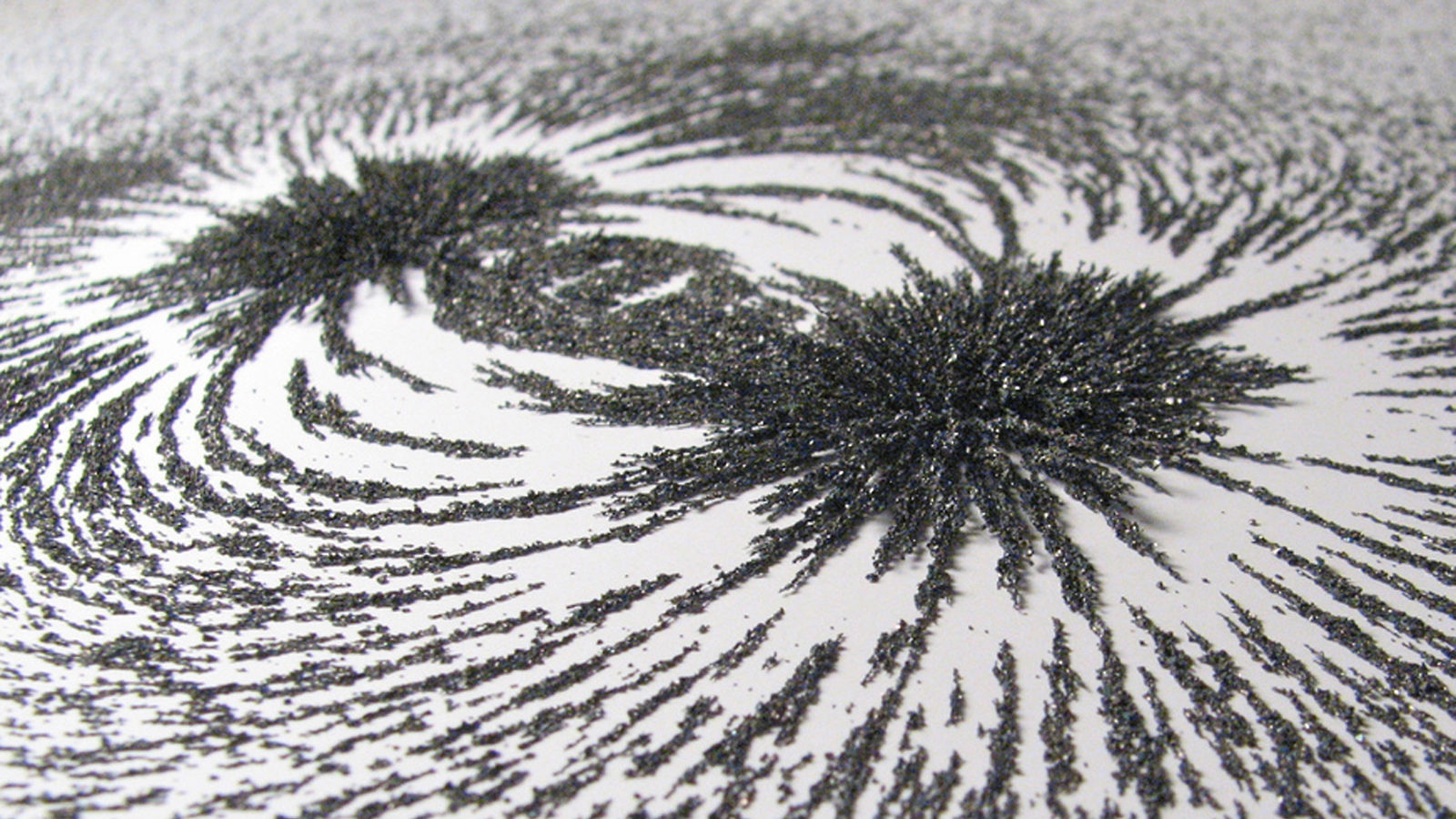
In the previous article, we already talked about manipulations with the properties of substances used in the creation of storage devices. In this case, it was the switching of ferromagnetic properties. And what if you do not use a magnetic field and do not touch on such concepts as magnetism? Is it possible to make a productive and reliable device? It was in this direction that Randall H Victora and Ahmed Rassem Wazzan conducted research. The main topic of this study was the management of the magnetic properties of nanostructures by means of an electric field. The goal was to consider the possibilities of creating energy-efficient high-density memory. We learn the details by reading the report of scientists. Go.
Gentlemen Victor and Wazzan developed the technique of micromagnetic simulation of the magnetoelectric effect (ME) in the basic structures of Cr 2 O 3 (chromium sesquioxide). It was found that the microscopic magnetoelectric susceptibility is very different from the experimentally obtained values. This difference becomes more pronounced when approaching the Curie point * , affecting the operation of the device at room temperature.
')
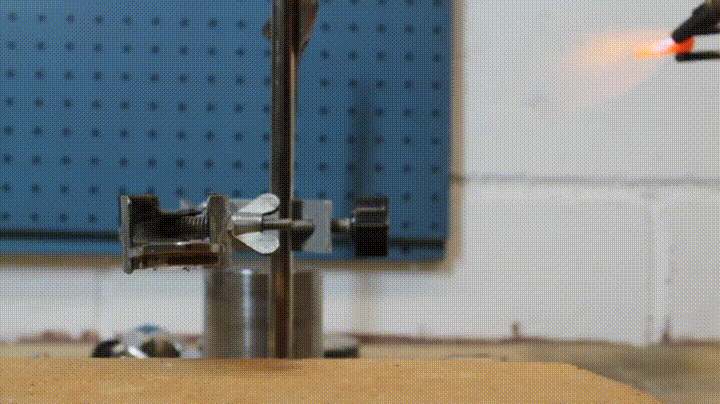
As a demonstration of the Curie point, we use the image from the previous article: a piece of iron heated to a temperature above the Curie point is only slightly attracted to the magnet. After cooling, its ferromagnetic properties are restored completely.
Curie point * is a parameter that determines the temperature at which a substance loses its ferromagnetic properties. When the temperature exceeds the boundary established by the Curie point, the intensity of the thermal motion of atoms increases and destroys the magnetic order of the electrons, i.e. the symmetry is broken, and the ferromagnet becomes a paramagnetic (a substance that can be magnetized by an external magnetic field, such as aluminum or lithium).It has been proposed to use an electric field that controls ME switching elements. In contrast to the traditional use of an alternating magnetic field, this technique uses quantum mechanical exchange. After the establishment of temperature-dependent physical parameters, the switching characteristics were studied under various variables: temperature, the applied electric field and the Cr 2 O 3 profile. It was found that the use of quantum mechanical exchange can reduce the required electric field and improve scalability, while maintaining thermal stability * .
Thermal stability * - the ability to preserve the original composition under the action of thermal loads.
The basis of technology
Researchers have attracted a lot of attention from magnetoelectric Cr 2 O 3 heterostructures due to the ability to switch the polarity of the exchange bias * of a ferromagnet using an electric field.
Exchange bias * is a feature of hysteresis loops ** of the magnetization reversal of magnetic materials, which manifests itself in an asymmetric arrangement of the loop relative to the ordinate axis.This switching is a consequence of the close connection between the boundary magnetization of the sample surface and the antiferromagnetic ordering inside the sample, which can be changed by applying an alternating electric field and a constant magnetic field. Such processes differ from those occurring inside other multiferroics * (for example, BaTiO 3 - barium titanate).
Hysteresis ** is a property of physical systems, the instantaneous response of which depends on their current state.
Multiferroics * are substances in which two or more types of ferro-ordering are present (ferromagnetic, ferroelectric, and ferroelasticity).The verification of the theory of this technology was carried out both on bulk Cr 2 O 3 and on a thin film of this substance. However, reducing the film thickness below 100 nm and lateral scaling to the size of modern CMOS devices faces a number of problems and difficulties. The thinner the film becomes, the lower the electromagnetic response becomes, and the level of energy required increases dramatically. Not to mention that in this case the antiferromagnet Cr 2 O 3 should work at the limit of electrical breakdown * .
Electrical breakdown * is the current surge in a dielectric that occurs when a voltage is above the critical voltage.In addition, the need to use a magnetic field in an exchange bias switching circuit, revealed in research, makes the system significantly less attractive for producing memory controlled by an electric field.
The smaller the device, the stronger the magnetic field should be, even if the electric field is operated on the verge of breakdown.
The conclusion from the above problems is the need to implement approaches that can reduce or eliminate the need for external fields. This study does not give unambiguous answers and is not the basis of a future revolutionary device. It is considering using only the electric field to control the magnetoelectric elements, while getting rid of the need for a magnetic field.
Scheme and structure
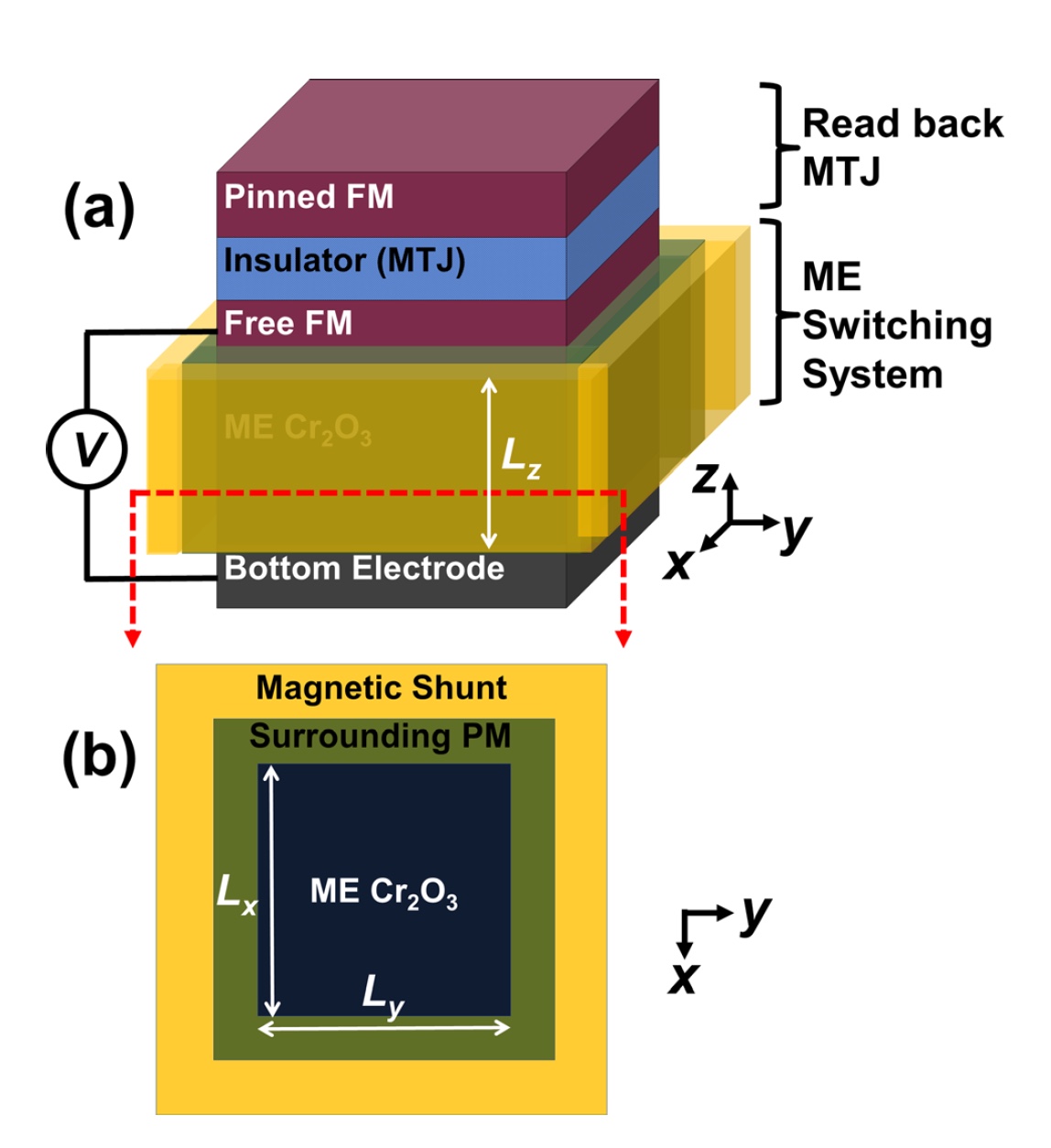
Image number 1
Image 1a shows a memory block based on Cr 2 O 3 . The device consists of a Cr 2 O 3 ME with a crystal structure of alpha alumina and a tunnel magnetoresistance reading unit * .
Tunnel magnetoresistance * is a quantum-mechanical effect that arises when current passes between two layers of ferromagnets separated by a thin layer of dielectric.Excellent results of antiferromagnetic coupling with surface spins of Cr 3+ have been demonstrated in combinations of Co / Pd * due to epitaxy * , as well as in combination of Co / Pt * by ion sputtering * .
Epitaxy * - the growth of one crystalline material on the surface of another at lower temperatures.The basis of the switching element is a rectangular core of ME Cr 2 O 3 , surrounded by a permanent magnet and a magnetic switch (magnetic shunt). This is schematically reflected in image 1b . A permanent magnet plays a critical role in providing the magnetic field required for Cr 2 O 3 through the exchange interaction of Cr 3+ moments. In other words, the need to use any magnetic field, internal or external, is exhausted by the field arising from the exchange interaction at the edges between the permanent magnet and Cr 3+ moments. A magnetic shunt is needed in order to break the stray field, which can adversely affect the neighboring components responsible for the applied field.
Ion sputtering * - the surface of a solid is bombarded by heavy charged particles (or neutral), which leads to the emission of atoms.
Co - Cobalt, is a ferromagnet.
Pd - Palladium, is a paramagnetic.
Pt - Platinum, is a paramagnetic.
Landau – Lifshitz – Hubert equation (LLG)
The equation taking into account thermal fluctuations describes the results of micromagnetic simulations of the structure proposed by the researchers.
The simulation of ME Cr 2 O 3 is associated with two unusual difficulties: the dependence of the magnetization on the electric field and the operation close to the Curie point.
The first problem was solved by using the linear magnetoelectric effect (ME) of an antiferromagnet (AF), where M = a E, under the influence of a magnetic field, which destroys the symmetry of two opposite sublattices. Simply put, if the electric field is absent, then the spin moments from the two opposite sublattices eliminate each other, producing zero magnetization.
* a
The second problem requires a clear understanding that internal properties such as anisotropy * (Ku), damping * (Ƞ) and exchange (A ex ) are important indicators of length scale measurements based on the theory of renormalization * .a - instead of alpha (sorry, I couldn’t insert a normal alpha into the text, so I used the letter “a”)
Anisotropy * - different properties of media in different directions inside the medium.
Damping * - elimination or reduction of oscillations in the mechanisms. You can also be seen as mitigating the negative impact of any effect on an object.
Renormalization * is a phenomenon in quantum field theory. The values introduced as external parameters of the problem may change as a result of the equations of motion (in our case, this is a map of the field evolution in time and space).The researchers gave preference to the numerical solution, rather than the analytical one, since it was necessary to get as real results as possible. For this, the predicted renormalized parameters (anisotropy, exchange and saturation of the magnetization) should coincide with the predicted atomic models that are valid even at temperatures close to the Curie point. The damping estimate was simplified by determining the similarity between the Cr 2 O 3 antiferromagnet sublattice and a ferromagnet (for example, FePt is an alloy of iron and platinum) and a scaling method based on previously calculated results.
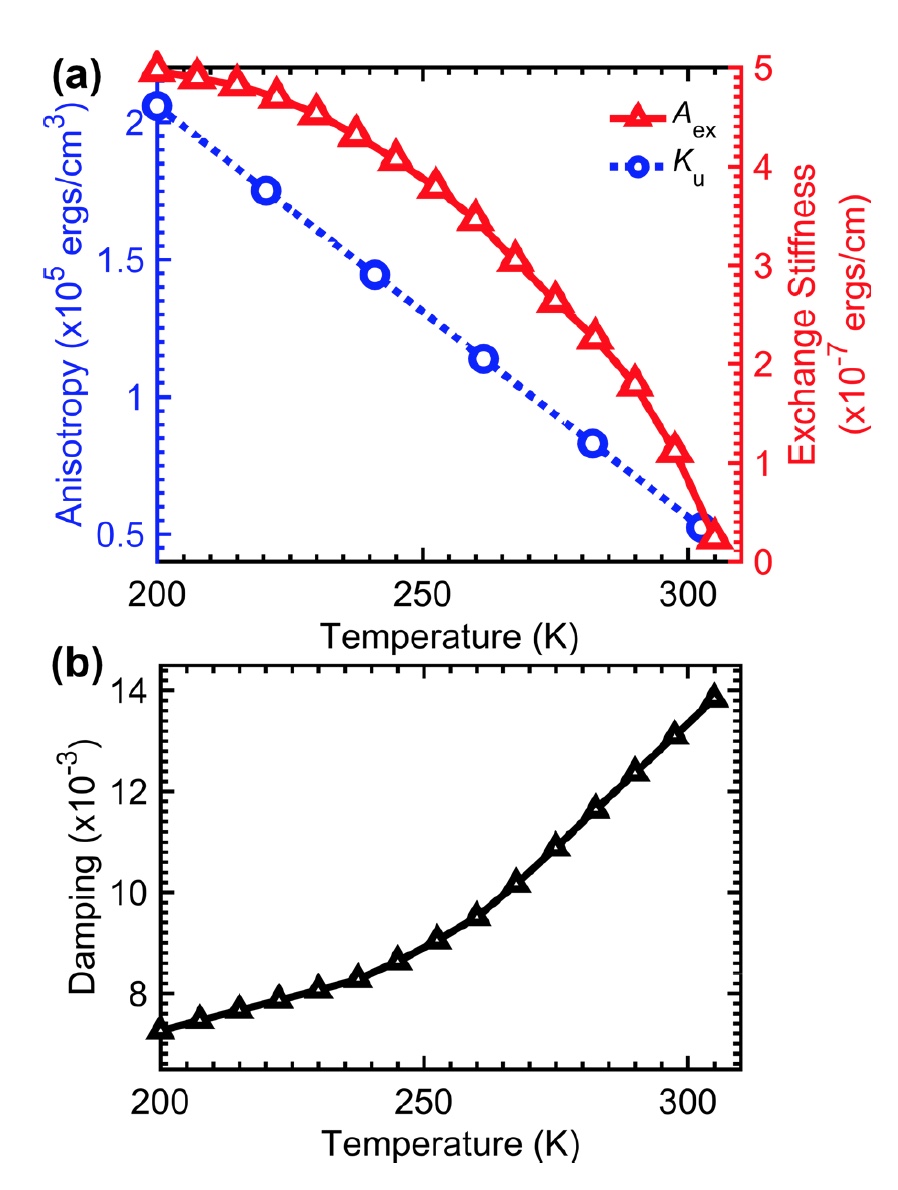
Image number 2
The image above ( 2a ) shows the calculated values of A ex , Ku, and Ƞ for a 1.5 nm length scale.
The main distinctive feature of Cr 2 O 3 modeling is the replacement of magnetization by a magnetic polarization enhanced by an electric field. This requires the renormalization of the magnetoelectric effect to the state opposite to the usual magnetization. Since such actions have not yet been described previously, the researchers had to apply a method that requires complete agreement between the results of large samples and the results obtained experimentally. This allowed us to extract a , necessary for calculations.
The magnetostatic interactions between the cells were ignored in the calculations due to the low magnitude of magnetization (<10emu / cm 3 ) and the relatively small size of the tested samples.
To check the changes in the ME in the critical temperature mode, the susceptibility of the ME was overestimated by the methods described earlier. Calculations were carried out for E = 2MV / cm and H = 6 kOe. To form a general idea of the ME, the calculations were carried out taking into account a uniform external magnetic field, rather than a non-uniform external magnetic field, as it is in the quantum exchange interaction at the edges of the sample.
The magnetoelectric susceptibility is defined as a obs (T) = [M (T)] / E , where [M (T)] is the average net magnetization of all cells. And a obs , in turn, represents the predicted magnetoelectric susceptibility required for the Landau – Lifshitz – Hilbert equation as an input parameter. The values of a iso were selected at each temperature index in such a way that the displayed a obs followed experimentally obtained values (A ex pt). The results of the analysis are shown in the image below ( 3 ).
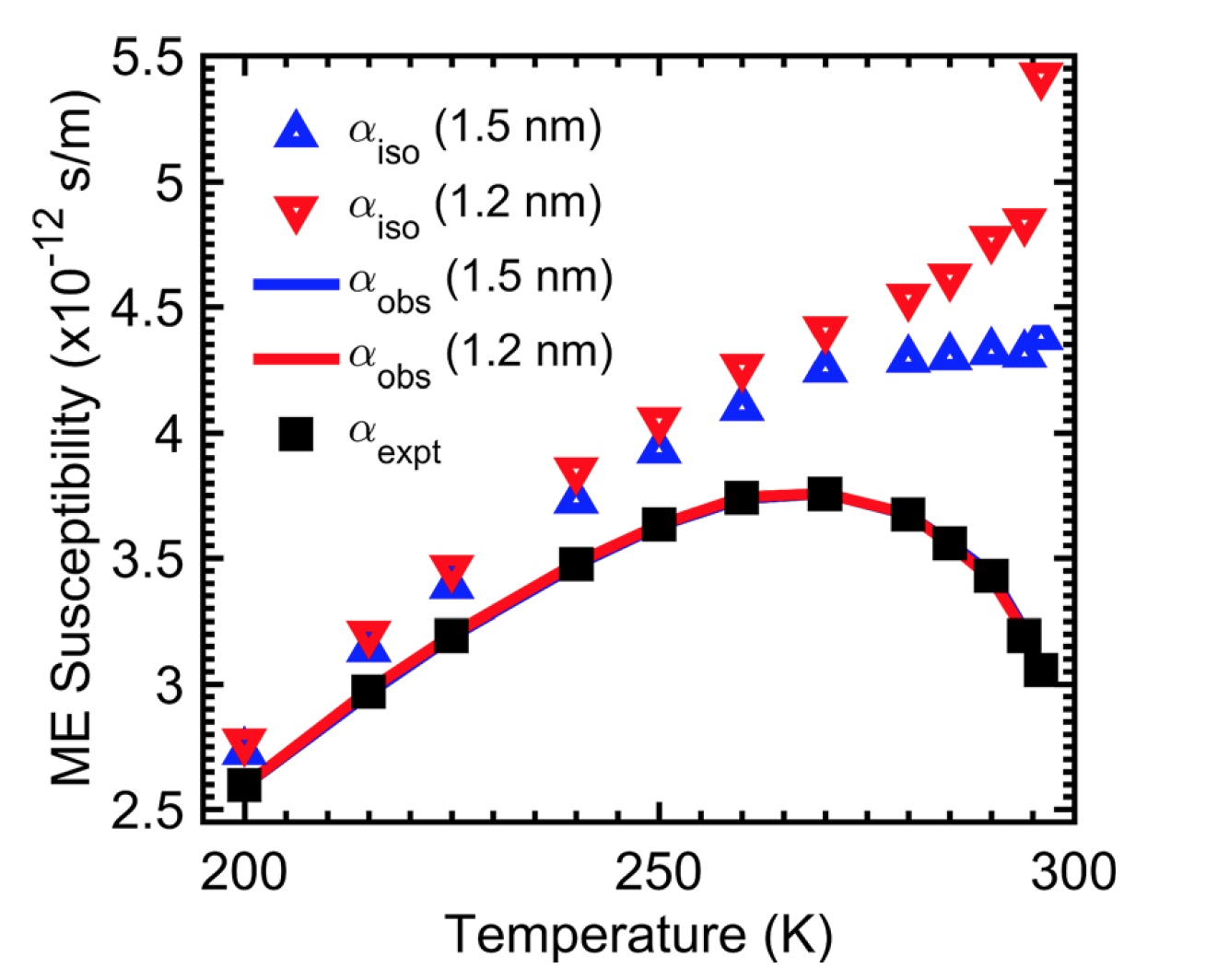
Image number 3
The graph shows a strong difference between the microscopic a iso and the observed macroscopic a obs for both sampling scales * .
Discretization * - transformation of a continuous function into a discrete one.While a obs and A ex pt do not follow a monotonous behavior, a iso gradually increases with increasing temperature. The closer the temperature is to the Curie point, the greater the difference between a iso and a obs . As the Curie point is approached, collective spin oscillations violate the microscopic ME-responses.
These results suggest that the strength of the magnetoelectric effect is greatly reduced when approaching the Curie point, even though the ME susceptibility at the atomic level is extremely strong. This suggests the need to improve the test sample in order to ensure its normal operation at room temperature.
Switching characteristics
The exchange field, emanating from the permanent magnet, completely eliminates the need to apply a magnetic field. The degree of exchange interaction between a permanent magnet and Cr 2 O 3 cells at the edges is expressed as: A PM = 2x10 -7 erg / cm. If this parameter is lower, then the exchange in the mode of critical temperature will be unstable. The orientation of the magnetization of a permanent magnet was constant to maintain a constant exchange field at the edges of Cr 2 O 3 . It was also found that the switching frequency of a cell with a volume of 1.5 nm 3 coincides with that predicted for 3% of the cells with a volume of 0.5 of the tested one.
The initial state of magnetization was balanced for 0.25 ns, after which an abrupt change (“switching”) of the electric field was made. It was noted that the reverse of the electric field led to a reverse of the maximum polarization - M max = a iso E. It follows from this that switching is actually initiated by changing M max in the LLG equation model.
The results of the switching tests are displayed in the image №4.

Image number 4
It should be noted, despite the fact that the reverse of the electric field leads to the reverse of antiferromagnetism (ie, the orientation of the uncompensated surface spins of Cr 2 O 3 ), the total magnetization remains in association with the unidirectional exchange field of the permanent magnet to minimize the required energy.
As a consequence, in order to demonstrate the switching of antiferromagnetic ordering, | M max | ⟨cos (θ) had to be used in all switching charts instead of ⟨M max cos (θ). Where θ denotes the orientation angle of the spin of the cell with the axis of perpendicular anisotropy (in image 1a is represented by the letter z ), and ⟨⟩ denotes the average value for all cells.
Switching at different temperatures is shown in image 4a . The calculations were carried out with the initial data: E = 2 MV / cm and Cr 2 O 3 22.5x22.5x60 nm. Several simulations were performed for each temperature, and the error display is represented by the standard error of 2r.
The deceleration of the switching process began to be observed with a decrease in polarization at higher temperatures, which is associated with terminal fluctuations * .
Terminal fluctuation * - deviations from the mean value of random variables caused by thermal movement of particles.Image 4b shows us the effect of an electric field on the switching process of the antiferromagnetic order. The set of graphs shown was obtained at a temperature of 296 K and thermal stability of 46 k B T at room temperature.
Interestingly, the switching was achieved with an electric field of only 0.5 MV / cm and no change in the peak value of ⟨cos (θ). This is seen in the inset in image 4b .
The researchers also noted that the switching speed increases with a weaker electric field. This is due to the faster, due to the exchange field of a permanent magnet, the spread of switching from the edges of Cr 2 O 3 to the center.
In order to understand how small the tested memory elements can be, several simulations were carried out with two options for the dimensions of Cr 2 O 3 : 15x15 nm and 30x30 nm. In this case, the electric field was 2 MV / cm, and the temperature was 296 K. The thickness was also kept at 60 nm for all the tested samples.
The results showed that in the absence of a permanent magnet exchange field, the required applied (homogeneous) field would be 14 kOe with the maximum permissible electric field strength. This indicator indicates the impracticality of using small elements based on Cr 2 O 3 using a magnetic field.
Graph 4c shows the switching curves for all three dimensions of Cr 2 O 3 . Logically, switching occurs much faster in smaller samples. This is explained by the fact that the exchange field of a permanent magnet spreads faster through a sample of a smaller area, which speeds up the process of minimizing the energy exchange.
Conclusions of researchers
The magnetoelectric effect was introduced into the LLG equation to evaluate its properties in Cr 2 O 3 , as well as for its possible use in switching elements based on the electric field.
The use of the renormalization approach allowed us to simplify micromagnetic calculations by using atomic Cr 3+ spins in hexagonal lattice sites in bulk Cr 2 O 3 cells in a cubic lattice.
Experiments were also carried out to determine the relationship between temperature and the switching process.
As a result, a sample was presented showing that there is no need for a magnetic field. Switching rates were increased by reducing the acting electric field and the Cr 2 O 3 area .
A device made of Cr 2 O 3 with dimensions of 22.5x22.5x60 nm with an electric field of 0.5MV / cm is capable of reliably and efficiently producing switchings below the Curie point and with thermal stability 46 k B T.
For acquaintance with details and research details I recommend to read the report of scientists
Unfortunately, open access to the full report is currently closed. However, I managed to download it before. Those who wish to familiarize themselves with it can download the report in PDF format by the link.
Epilogue
The scientists who conducted this study did not plan to make a breakthrough. They needed to understand the limiting properties of physical phenomena in conjunction with the use of certain chemical compounds. The research results provide grounds for new research in this area, which, subsequently, may lead to the commercial implementation of their prototypes. The process of studying the possibility of using only the electric field and the rejection of the magnetic is hampered by incredibly complex experiments. In order to only understand all the processes occurring in the process of one test, you need a lot of knowledge, patience and effort. What to say about the implementation of projects based on these studies. However, any study that discovers or explains even the most insignificant physical or chemical process and / or phenomenon already takes on local importance. In other words, exaggerated, if humanity had not opened the wheel, there would be no cars. If you are a researcher, never underestimate the importance of your work. Who knows, maybe years later your achievements will give impetus to a new, uninvited earlier technology.
Thank you for staying with us. Do you like our articles? Want to see more interesting materials? Support us by placing an order or recommending to friends, 30% discount for Habr users on a unique analogue of the entry-level servers that we invented for you: The whole truth about VPS (KVM) E5-2650 v4 (6 Cores) 10GB DDR4 240GB SSD 1Gbps from $ 20 or how to share the server? (Options are available with RAID1 and RAID10, up to 24 cores and up to 40GB DDR4).
Dell R730xd 2 times cheaper? Only we have 2 x Intel Dodeca-Core Xeon E5-2650v4 128GB DDR4 6x480GB SSD 1Gbps 100 TV from $ 249 in the Netherlands and the USA! Read about How to build an infrastructure building. class c using servers Dell R730xd E5-2650 v4 worth 9000 euros for a penny?
Source: https://habr.com/ru/post/374511/
All Articles